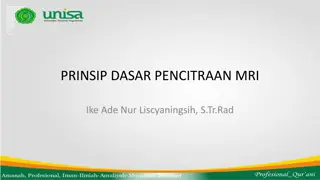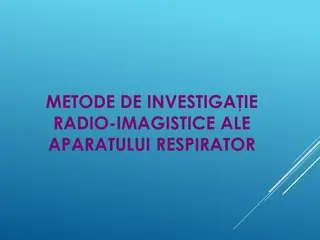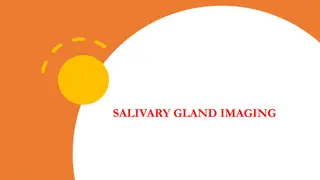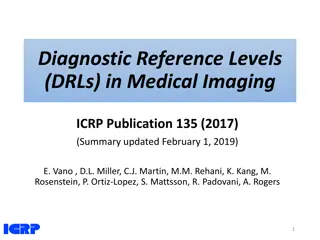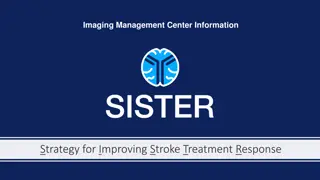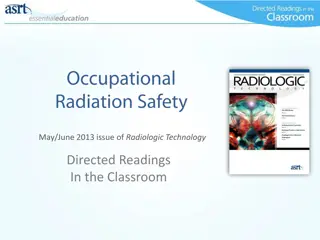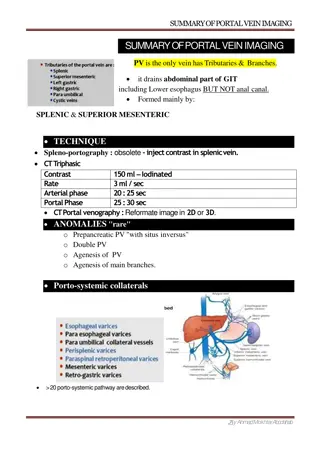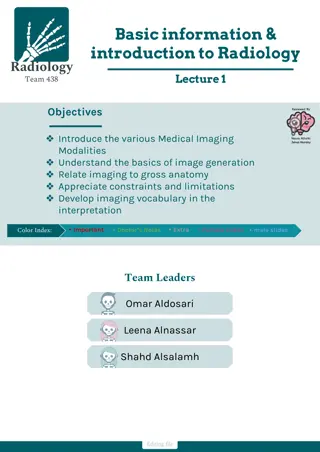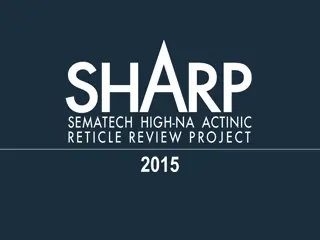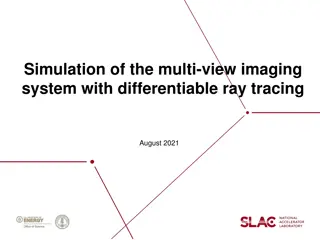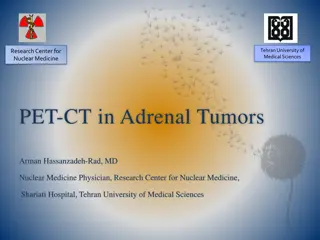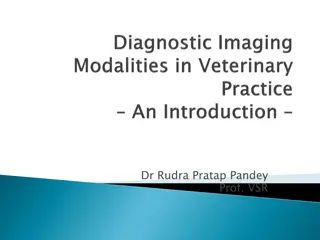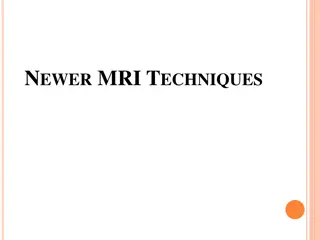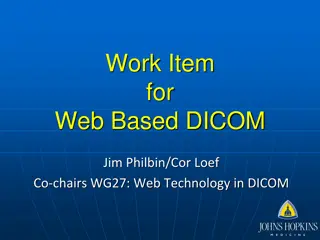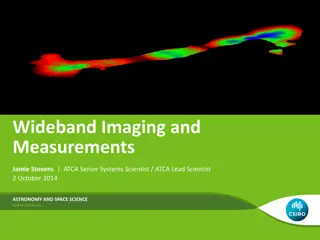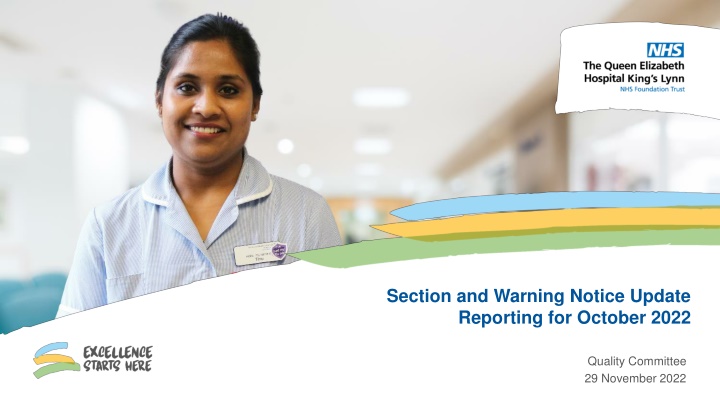
Integrating Imaging and Information Systems for Healthcare
This content discusses the integration of DICOM and HL7 for improved communication of imaging results in healthcare processes. Topics covered include transcribed diagnostic imaging reports, communication enhancement strategies, and structured document exchange benefits. The intersection of DICOM SR and HL7 CDA, along with key features like transformation guides and report quality improvements, are also highlighted.
Download Presentation

Please find below an Image/Link to download the presentation.
The content on the website is provided AS IS for your information and personal use only. It may not be sold, licensed, or shared on other websites without obtaining consent from the author. If you encounter any issues during the download, it is possible that the publisher has removed the file from their server.
You are allowed to download the files provided on this website for personal or commercial use, subject to the condition that they are used lawfully. All files are the property of their respective owners.
The content on the website is provided AS IS for your information and personal use only. It may not be sold, licensed, or shared on other websites without obtaining consent from the author.
E N D
Presentation Transcript
Section and Warning Notice Update Reporting for October 2022 Quality Committee 29 November 2022
Summary of Progress This report details the progress against the Section and Warning Notices during October 2022, following the transition from the 2021/22 IQIP to the new 2022/23 Compliance Plan which went live April 2022. There are 4 Section & Warning Notice Conditions on the Trust Certificate of Registration. All 4 Section 31 Conditions have been closed internally by the Trust Evidence Assurance Group and moved to business as usual and incorporated into the 2022/23 Compliance Plan and monitored as part of business as usual at both Divisional and Corporate level. 4/4 = 100% of all Section and Warning Notice conditions have been approved and moved to Business as Usual. A decision was made not to submit a formal application at this time to request the lifting of 3 of the remaining Section 31 Conditions relating to Maternity Services and Diagnostic Imaging. The rationale for this decision is detailed below: Maternity Services: Although monthly audits are completed for MEOWs, the results remain below the required compliance standard. Therefore the team have requested a further 6 months to meet the required compliance standard and have agreed recovery actions. Diagnostic Imaging: Due to a lack of robust evidence regarding the escalation of Significant Findings, as part of agreed recovery actions a complex process is underway with AGFA to program the RIS system to create an automated escalation process for Significant Findings together with audit process. The second Radiology Condition relates to having a robust system in place to facilitate effective clinical governance. In view of the need for further evidence relating to significant findings, any application to request the lifting of the 2 remaining Radiology Conditions will need to be submitted simultaneously. Advice was sought on how to progress the closing of the 4th condition (triage of patients within 15mins) at the monthly QEH/CQC relationship meeting in September. It was agreed that evidence will be required to detail changes made and improved compliance, appreciating there will be variation depending on operational pressures. Particular evidence and assurance is required for paediatric patients regarding the 15min triage recognising these patients can deteriorate quickly. Evidence of the average triage times to all direct ED areas, details of incidents relating to triage and complaint data. Discussions are ongoing with the Emergency Department leadership team to review evidence and changes made. As part of this the CQC have been invited for an informal visit in January 2023 which will include a visit to the Emergency Department. A decision has been taken to temporary split Urgent & Emergency Care from the Division of Medicine with a dedicated Senior Leadership Team to provide strengthened focus on the Urgent & Emergency care pathway. The Quality Committee is asked to: Note the current 2022/23 Compliance Plan position as at Month 07 Note the update regarding the remaining 4 Section 31 Notices
Summary of Progress Maternity & Midwifery Services The Registered Provider will ensure that there is appropriate escalation of deteriorating patients in line with current guidelines and best practice. With full medical handover at 9am and 7pm, with ward rounds at 12.30pm and 5pm. Progress Update Medical handovers form part of the Maternity Improvement Plan, in order to provide maximum oversight and assurance that responsible clinicians remain regularly sighted on patient care and any potential escalation requirements. Regular MEOWS audits are undertaken to ensure patients are having their MEOWS scores documented promptly, with any required escalation also actioned, and documented, and MEOWS scores re-taken where necessary. Risk & Mitigations There has been a recent trend in recently completed Serious Incident investigations in relation to missed opportunities to escalate deteriorating patients as early as possible. Learning points have been identified from these investigation and robust communication throughout the division is in place in relation to these learning points, including discussion at Clinical Governance, SixSlides learning packs assembled, and hot and cold staff debrief sessions. MEOWS audit data for September and October have revealed some concerns in relation to escalation plans being documented effectively. Ward managers and Matrons have informed staff of areas where improvements must be made, and communication is ongoing to develop clear action points via staff meetings and huddles. Next Steps Medical handovers to be embedded in consultant schedules as part of job planning. Further MEOWS audits ongoing and further interrogation of data to be undertaken to identify any key areas of concern.
Summary of Progress Urgent & Emergency Care The registered provider must ensure that there is an effective system in place to robustly assess all patients who present to the ED in line with relevant national clinical guidelines within 15 minutes of arrival. Progress Update A double up triage/streaming pilot has been commenced within ED to support improvement in achieving 15 minute triage standards. This means that two RNs instead of 1RN with the support of an extra HCA , who commences ECGs, bloods and observations triage on arrival. Risk & Mitigations The pilot is dependent on available staff so could be at risk with short term sickness. Mitigations are that the shifts have been put out to bank and could utilise agency workforce if required. There is also clear direction that the pilot must be protected and escalation to seniors is required to utilise the allocated staff elsewhere within the department Next Steps This pilot will run for 4 weeks after which feedback and performance data will be analysed and outcome provided. It is expected that this will become business as usual as improvements have been seen from commencement of the pilot.
Summary of Progress Diagnostic Imaging The registered provider must ensure that an effective system is in place for the regular oversight of the appropriate escalation of significant findings. This should include diagnostic imaging undertaken out of hours to ensure that any patients at risk are escalated appropriately. Progress Update This is linked to Phase 2 of the Radiology Information System (RIS) project and a paper has been presented to the Safe Executive Group regarding part of this action what part. The Radiology Team will audit the systems use after 2-3 months to evidence sustainability. Risk & Mitigations Current process in place with established lines of communication for significant findings. Reliant on Medical Secretaries but reports available on ICE in full as per normal process. Out Of Hours (OOH) provider has mechanisms in place to escalate to clinicians significant findings. OOH reporting provider has audit process to monitor process. Next Steps New alert system to be implemented and this will feed into planned audits of the system to ensure effectiveness.
Summary of Progress Diagnostic Imaging The registered provider must ensure that there is robust system in place to facilitate effective clinical governance within the diagnostic imaging department. This is to include oversight of training, compliance to scope of practice, learning from incidents and escalation processes. The registered provider must ensure that there is a systematic approach to audit to measure compliance with protocols, processes and professional standards. The registered provider must ensure that there are processes in place for effective communication within the Diagnostic Imaging Department. Progress Update Substantive Radiology Risk and Governance Manager in post. Department has a robust rolling audit plan and reporting mechanisms to share and disseminate results to staff and Divisional Leadership Team. Departmental staff meetings now taking place on a regular basis with focus on learning from incidents. Senior Leadership Team have regular meetings with Clinical Director to ensure departmental wide communication and established escalation process to senior management, Risk & Mitigations Support for Radiology Risk & Governance Lead from Clinical Support Services Risk and Governance Lead. Embedded meetings in Radiology calendar, with allocated time to support. Audits have been streamlined and made more manageable. Next Steps To review compliance and structure of competencies and preceptorship of staff. This will be with a view to align with professional internal and external standards
Summary of Progress 4 = 100% of all Section and Warning Notice conditions have been approved and moved to Business as Usual CQC Conditions & Notices 4 Total Complete 4 Total Planned 100% 0% 100%
Section 31 Condition Formal Application Outcome All of the four remaining Section 31 conditions have been closed internally by the Trust and ongoing compliance is monitored as part of business as usual at Divisional and Corporate level. Section 31 Condition Status: Total Section 31 ConditionsReceived Number of S31 Lifted Total Section 31 Conditions Remaining Core Service Date Received Date Lifted Jan 2021 April 2021 October 2021 April 2021 5 2 2 6 Maternity & Midwifery Services July 2018 10 1 Urgent & Emergency Care March 2019 8 1 October 2021 1 Diagnostic Imaging May 2019 4 April 2021 2 2 Total Section 31 Conditions 22 18 4
Section 31 Condition Conditions that remain on the Trusts Certificate of Registration Maternity & Midwifery Services The Registered Provider will ensure that there is appropriate escalation of deteriorating patients in line with current guidelines and best practice. With full medical handover at 9am and 7pm, with ward rounds at 12.30pm and 5pm. Urgent & Emergency Care The registered provider must ensure that there is an effective system in place to robustly assess all patients who present to the ED in line with relevant national clinical guidelines within 15 minutes of arrival. Diagnostic Imaging The registered provider must ensure that an effective system is in place for the regular oversight of the appropriate escalation of significant findings. This should include diagnostic imaging undertaken out of hours to ensure that any patients at risk are escalated appropriately. The registered provider must ensure that there is robust system in place to facilitate effective clinical governance within the diagnostic imaging department. This is to include oversight of training, compliance to scope of practice, learning from incidents and escalation processes. The registered provider must ensure that there is a systematic approach to audit to measure compliance with protocols, processes and professional standards. The registered provider must ensure that there are processes in place for effective communication within the diagnostic imaging department.


